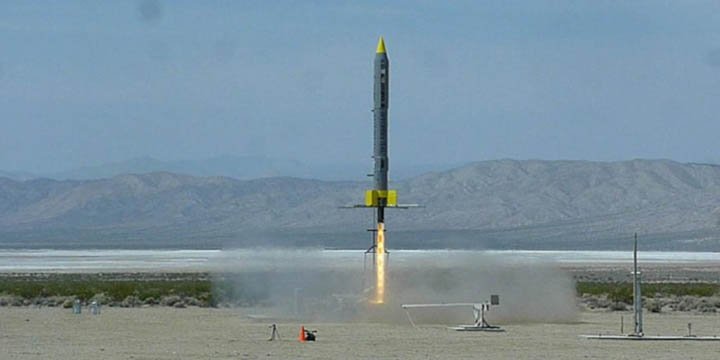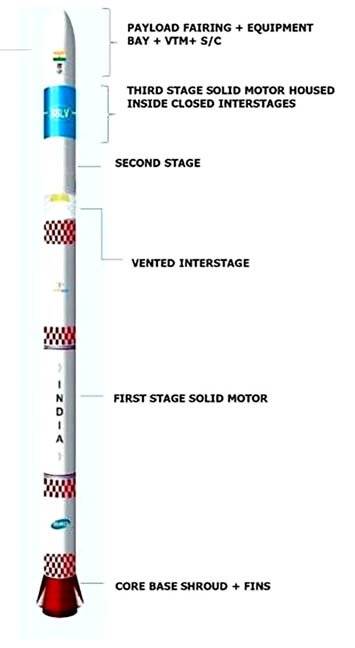SMALL SATELLITE LAUNCH VEHICLE (SSLV)
WHY IN NEWS?
- The Small Satellite Launch Vehicle (SSLV), proposed in 2016 was seen as India’s challenge to the dominance of the US in space launch services. But in the past two years, it has only seen two demonstrator launches.
ABOUT SSLV:
- The SSLV is a small rocket in size and capacity, in comparison to other rockets of Indian Space Research Organisation (ISRO).
- Small Satellite Launch Vehicle (SSLV) is a 3-stage Launch Vehicle with three Solid Propulsion Stages and liquid propulsion based Velocity Trimming Module (VTM) as a terminal stage.
- It is 2m in diameter and 34m in length with lift off weight of approx 120 tonnes.
- It is also capable of launching payload of around 500kg satellite in 500km planar orbit.
- On the other hand, Polar Satellite Launch Vehicle (PSLV) can carry up to 1.75 tonnes in satellite payload and Geosynchronous Satellite Launch Vehicle Mark-III (LVM3) can carry up to 8 tonnes.
KEY FEATURES OF SSLV:
- The main features of SSLV are Low cost, with low turn-around time, flexibility in accommodating multiple satellites, Launch on demand feasibility, minimal launch infrastructure requirements, etc.
WHY SSLV IS NOT SO SUCCESSFUL?
- Although the first SSLV demo launch was a part-failure but the second launch was a success.
- IN-SPACe’s FY25 launch schedule shows only three scheduled launches in the next 12 months.
- A large part of unpopularity is due to engineering requirements as a key part of making small rockets successful is reliability, which often takes years in the space sector.
- Apart from this, the space sector itself has been slow as the demand for commercial operators being very limited.
- Elon Musk’s SpaceX is the SSLV’s biggest rival, owing to the former’s small satellite ride-share programme.
- Other competitors inlude US-based Rocket Labs, which uses its small rocket ‘Electron’ for frequent launch missions.
- In India, startups Skyroot Aerospace and Agnikul Cosmos also hope to attract some market share.
REASONS OF FAILURE OF PAST SSLV MISSIONS:
- According to the released summary of the failure analysis report by Isro shows that during the separation of the second stage, there were vibrations exceeding in frequency and time duration than expectations or ground-test levels.
- In the terminal stage, there was malfunctioning of a sensor, which led to the satellites being placed in an elliptical orbit instead of a 356 km, low-Earth, circular orbit.
- Thus, the satellites that the vehicle was carrying failed to be placed into the desired orbits and were lost.
IMPORTANCE OF SSLV IN INDIA’S SPACE SECTOR:
- Due to slowing of demand firms that had plans for commercial small-satellite constellations are actively reconsidering their launch plans.
- Lack of demand is leading to a revision in the projected demand for satellite launch services.
- Much of the SSLV’s success will depend on this demand, which, at the moment, remains low.
- As the large-capacity rockets have long waitlists as they wait for a single large order or the ‘primary’ payload.
- Therefore, private commercial firms often wait for years until they can launch their small satellites.
- The SSLV can help resolve this with faster, cheaper launch cycles as this model helps cut satellite launch costs.
- According to experts, though a chunk of the SSLV’s demand will come from India itself, but a regularized commercial launch schedule for the small rocket may take up to another four years.
ABOUT INDIAN PRIVATE START-UPS IN SPACE SECTOR:
- Till now no Indian private space firm has made an orbital launch with a satellite payload.
- As space launches are capital-intensive, so startups have a tough job to not burn too much capital in earning credibility and proving their reliability to commercial clients.
- On the other hand, SSLV is backed by Isro and operated by its commercial arm, NewSpace India Ltd.


